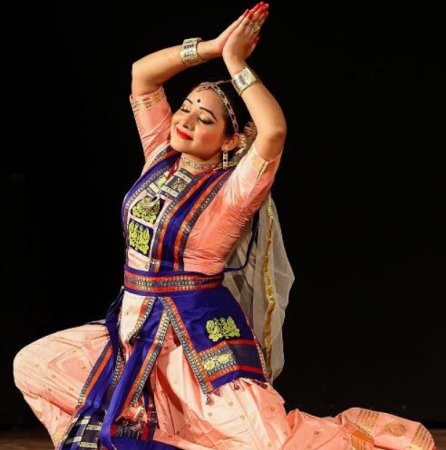
|
 |

|
 |
Sanctity of the term 'Guru' in Sattriya parlance - Meenakshi Medhi e-mail: meenakshisattriya@gmail.com Photo: V.K. Amuthan June 25, 2020  Some profound moments in life make you think and introspect. During one of my performances, the organizers added the prefix Guru to my name in the banners and invites; it somehow did not feel right and upsets me till today. Many a time, I have also been asked by my students why they should not address me as a Guru. I never had a definitive answer. I feel that the word Guru has great sanctity. It also may have stemmed from my experience with all the great exponents of the dance forms. I have not seen anyone address himself as a Guru. The thought remained with me and hence the first thing I did was Google. I was not satisfied and hence I referred to my Adhyapak and elders who had a deep-rooted link to our Sattriya tradition and the revered scriptures that we as practitioners follow. After a lot of discussions, deliberations and reading a lot of texts, here is what I could come up with for my justification to be called an Adhyapika. Google cites Guru to be "A Hindu spiritual teacher" or "An influential teacher or popular expert". Also, the word can be broken up as Gu= Darkness and Ru= Remover to mean remover of darkness or ignorance. The one who enlightens you. But as practitioners of Sattriya dance and humble learners of the tradition, if we delve into the Vaishnavite culture and the Shrimad Bhagavat, we find mention of three types of Gurus: 1. Adi Guru (parent) - who gives us birth and instills in us moral and cultural values. 2. Dwe Guru or Shiksha Guru (teacher) - who delivers us knowledge and skills for livelihood. 3. Diksha Guru (spiritual master) - who gives us spiritual enlightenment. According to different Tantra sastras and Samhitas, we find the use of various terms like Visistha Guru, Sadguru and Jagatguru. Adi Guru, Dwe Guru and Diksha Guru can all be understood as Visistha Guru who is a Guru for a particular person, Sadguru is the true Guru of all and Jagat / Anandi / Parama Guru is the one whom we cannot see through our naked eyes but can only feel through pure devotion. Being a practitioner of Sattriya dance, we have a very special term for our Shiksha or Visistha Guru which is 'Adhyapak'. Parama Guru Mahapurush Srimanta Sankaradeva who laid the foundation of Sattriya culture to spread bhakti movement through the medium of dance, music and drama had no formal Guru but spiritually he acknowledged 'bhakat' to be his guru. Interestingly, Srimanta Sankaradeva considered his disciple Mahapurush Madhavadeva to be a guru as he exhibited all the traits of an ideal bhakat. To be an ideal bhakat as per Srimanta Sankaradeva in Bhakti Ratnakar, a bhakat has to have multiple attributes such as kindness, forbearing, fortified in truth, free from impurities of the mind, unperturbed in happiness and in suffering, ever helpful, master of the senses, pure, possession-less, non-attached, calm, firm, etc. First and foremost to be a Guru, you have to be an ideal bhakat. Hence, I found solace in the fact that the word 'Adhyapak' in our tradition is indeed an effort to keep the reverence of the term 'Guru'. We may be devoted to the dance form and be in the continuous pursuit to spread the dance form but yet we lack too many qualities of being a bhakat and thus a Guru. Some may even have forsaken the desire of money and are teaching against any commercial considerations [not saying that teaching and accepting money is wrong; commercial considerations are essential for living and existing] but still may not have the other qualities and would be wrong to be considered a Guru. Likewise, simply by being a great teacher or being a terrific performer or even by becoming a great choreographer one does not become a Guru. Guru is a culmination of multiple traits and it would be a sacrilege to demand to be addressed as a Guru just because he/she has taught / choreographed / performed incredibly. We can find the following excerpt in Naam Ghoxa which exemplifies the thought above: Naajane saastrara nay Yehi aaxe taake kaya Chedibaaka naapaare xansay Guru bulaai tathaapito lukara maajatu xitu maanyo xatakaara khuji lay Madhavadeva in this excerpt warned people not to fall for a person who may not really know anything of the sastras to solve doubts and difficulties of their students, but still declare themselves to be a Guru to earn their livelihood. I would like to sum up with a quote of Gautam Buddha, "There is only one moment in time when it is necessary to awaken. That moment is now." May Anandi Guru's blessings be always with us. Delhi based Sattriya dancer and teacher Meenakshi Medhi is a disciple of Adhyapak Haricharan Bhuyan Borbayan. A solo artist performing across India for over a decade now, she is the founder of Satkara-Unleashing the Spirit of Sattriya. Post your comments Please provide your name and email id when you use the Anonymous profile in the blog to post a comment. All appropriate comments posted with name & email id in the blog will also be featured in the site. |